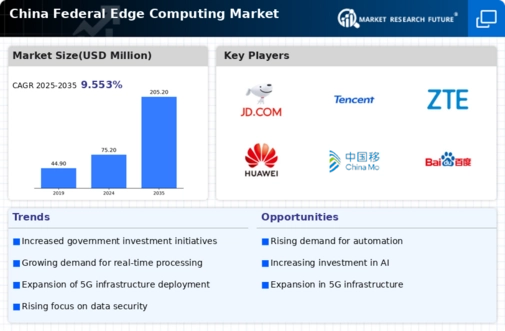The China Federal Edge Computing Market is rapidly evolving, driven by the increasing adoption of AI and IoT technologies, as well as the demand for low-latency processing capabilities. Companies in this sector are focusing on enhancing their edge computing solutions to meet the needs of various industries, such as healthcare, manufacturing, and retail.
The competitive landscape is characterized by a mix of established tech giants and emerging start-ups that are innovating to create value for consumers and businesses alike. As organizations look to leverage edge computing to improve real-time data processing and reduce bandwidth constraints, the market is positioned for significant growth in the coming years, attracting substantial investments and innovations.
JD.com has established itself as a formidable player in the China Federal Edge Computing Market, leveraging its robust logistics and supply chain infrastructure to enhance its edge computing capabilities.
The company's primary strength lies in its comprehensive understanding of e-commerce and consumer behavior, enabling it to implement cutting-edge edge computing solutions that improve operational efficiencies and customer experiences.
JD.com has invested heavily in building its technology stack, which allows for real-time data processing and analytics. The integration of edge computing into its logistics operations enables JD.com to optimize inventory management, respond to customer demands efficiently, and ensure seamless order fulfillment.
This strategic focus on innovation and customer-centric solutions solidifies JD.com's position in the competitive landscape.
Tencent is another major player in the China Federal Edge Computing Market, recognized for its extensive ecosystem of digital services and products. With significant market presence, Tencent leverages its technological strengths in cloud computing to provide robust edge computing solutions that cater to the diverse needs of various industries.
The company's key products include its cloud services, gaming infrastructure, and social media platforms, all of which benefit from edge computing capabilities that enhance user experiences. Tencent's strategic partnerships and collaborations have fostered a competitive edge, enabling it to stay at the forefront of technological advancements.
Moreover, through targeted mergers and acquisitions, Tencent has expanded its service offerings, enabling more comprehensive solutions tailored to China's unique market dynamics. Its emphasis on R&D ensures that Tencent continues to innovate and remain competitive in the fast-evolving landscape of edge computing in China.










